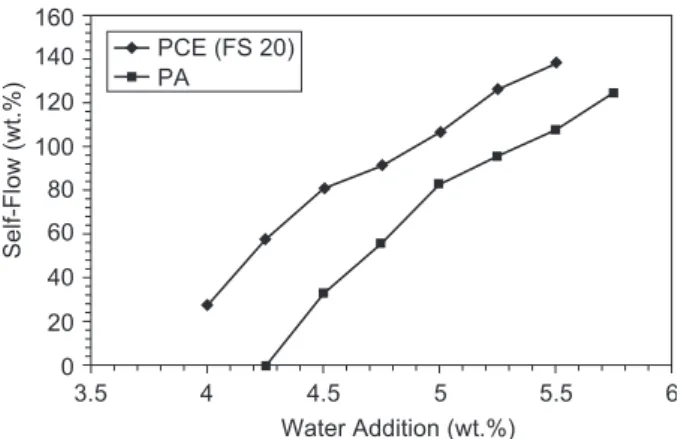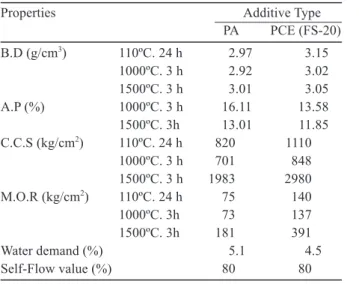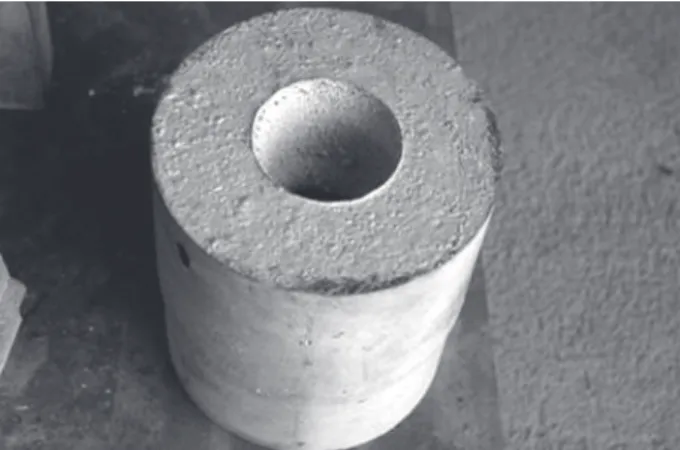THE EFFECT OF ADDITIVES ON THE PROPERTIES OF HIGH
ALUMINA LOW-CEMENT SELF-FLOWING CASTABLES
SASAN OTROJ, MOHAMMAD REZA NILFOROUSHAN, REZA MARZBAN* Department of Engineering., University of Shahrekord, Shahrekord, Iran
*Gadr (Niru) Refractories Co., Tehran, Iran E-mail: sasan.otroj@gmail.com
Submitted August 12, 2008; accepted October 2, 2008
Keywords: Additive, Deflocculant, Self-flow, Low-cement castable, Microstructure
In this paper, the effect of additives such as deflocculants and dispersants; on the properties of alumina low-cement self-flowing castables has been investigated. The flow and setting behavior, major physical and mechanical properties of these castables have been tested. Also, the microstructures of these castables have been evaluated. The results show that the proper choice of deflocculants such as; polycarboxylateether is essential for the development of these castables and improvement of their microstructure and properties. The optimum content of this deflocculant is considered to be 0.06 wt.%.
INTRODUCTION
A family of castables has been developed and successfully used in a wide variety of refractory applications over the past few years. These types of castables will flow under their own weight and easily fills intricate forms and shapes without any external force, which makes the installation operation easier and fewer dependants on the skill and the carefulness of the workers [1-4]. Therefore, the self-flowing castables can easily reach and fill in complicated or narrow space where it is difficult for a vibrator to reach. Those lead to self-level and self-degas so forming a homogeneous structure without any segregation and bleeding. The main advantages of self-flowing castables in comparison with vibration castables are smaller pore size and more uniform pore size distribution, fewer mold defects, good service performance, noise-free, saving man-power, time and vibration facilities. Due to these advantages, the consumption of self-flowing castables has increased considerably. In order to have self-flowing castable, a few parameters have great effects which are the particle size as well as particle distribution, also type of raw materials and additives, such as deflucculants and dispersants.
On the other hands, the additives interaction with the hydraulic agents during the hydration periods affects on castable properties such as workability, setting time and initial mechanical strength. Therefore, it is necessary to optimize additives used for any specific system [5-10]. The main purpose of this work is to evaluate the influen-ce of additives such as deflocculating agents on the flow and setting behavior in a system composed of alumina, calcium aluminate cement and microsilica such as, high alumina low-cement self-flowing castables and also investigation of major physical, mechanical properties and its microstructure. For this purpose, four commercial deflocculants namely; sodium polymethacrylate (PA), citric acid (CA) and two types of polycarboxylateether (PCE) were used and the results are shown.
EXPERIMENTAL Raw materials and composition
The composition prepared for experiments were high alumina low-cement castable. The source of raw mate-rials preparation together with the composition used for mixing of low cement castable are shown in Table 1,
Table 1. Raw materials and composition of the high alumina low-cement castable.
Raw materials Source (Type) (wt.%) Tabular Alumina 2-5 mm Alcoa Chemicals, T-60 78
1-2 mm 0.5-1 mm 0-0.5 mm
≤ 45 μm
Microsilica d50 = 0.25 μm Elkem, 971U 5
Reactive Alumina d50 = 1.90 μm Alcoa Chemicals, CTC-20 12
Ceramics – Silikáty 53 (1) 42-47 (2009) 43 also chemical composition of raw materials are listed
in Table 2. The castables used for studying was formula-ted according to Andreasen‘s particle size distribution model as follows:
CPFT = 100× (d/D)q (1)
where, CPFT, d, D and q indicate the cumulative percentage finer than, particle size, the largest particle size (5000 µm) and the distribution coefficient, respectively. In order to achieve self-flow, the q values should be in the range 0.21-0.26 [11]. For the present study, q was chosen to be 0.24, and the particle size distribution of the castable with this value of q is represented in Figure 1. The physical properties and the source of deflocculants used in this study are listed in Table 3.
Self-flow measurements
Self-flow value and working time measurement was performed according to ASTM C 1446-99. Based on this standard, after dry mixing of the batch for 30 s in a planetary mixer (Hobart), all the water (distilled)
was added within 10 s while the mixer was running. The wet mixing was conducted for 5 min at a slow speed (Hobart, speed 1). After mixing, the prepared castable, was transferred to a sealed container and care was taken to keep the moisture constant. Ten minutes after addition of water, the mixed castable was poured into a standard cone with a base diameter of 100 mm according to ASTM standard number C-230. The cone was then elevated to allow the mix to flow, and after 60 s the patty diameter was measured. The percentage increase in spreading diameter after 60 s is taken as the self-flow value according to the following formula:
Self-flow (%) = (D2 – D1) × 100/D1 (2)
where D2 is the final average diameter after removal
of mould and D1 is the initial diameter (100 mm). The
castable is considered as self-flow, when the above value lies within the range of 80-110 % of the base diameter. During the self-flow evaluation, the ambient temperature was controlled to be in the range of 20-24°C [12].
Castable preparation
The dry constituents of the castable were mixed for 4 min, water was added, and the whole composition was wet mixed for an additional 4 min. This castable was cast into standard mold without vibration. After curing at 20°C and 90 % relative humidity for 24 h, the speci-mens were taken out of the mold, dried for 24 hrs at 110°C and fired at 1000 and 1500°C for 3 hours respec-tively. Bulk density (B.D), apparent porosity (A.P), cold crushing strength (C.C.S), cold modulus of rupture (C.MOR) of the specimens was measured after drying and firing at each individual temperature. Bulk density and apparent porosity of dried and at 1000 and 1500°C fired samples were determined by the water immersion method (in accordance with ASTM C 830-93). Also, cold modulus of rupture (3-point bend test) and cold crushing strength were performed in accordance with ASTM C 133-97. Bulk density, porosity and mechanical strength data presented in this article correspond to an average of five specimens for each composition and at each firing temperature.
Microstructure evaluations
In order to microstructure evaluations, scanning electron microscopy (SEM) (Cambridge S-360) was performed on polished sections after gold coating.
Ener-Table 2. Chemical composition of raw materials (wt.%). Oxide Tabular Microsilica Reactive Cement
Alumina T-60 Alumina Secar-71
Al2O3 99.4 0.47 99.8 72.7 Na2O 0.36 0.01 0.06 0.19 CaO 0.05 0.3 0.02 26.5 MgO 0.10 0.22 0.02 0.09 SiO2 0.02 96.45 0.03 0.2 Fe2O30.10 0.10 0.44 0.03 0.11
Table 3. Specifications of used dispersants.
Additive M.W. (g/mol) Molecular Structure Type Source
Sodium Polymethacrylate (PA) 2500 Linear Darvan 7S Vanderbilt
Citric Acid (CA) 192 Linear – Kimia Mavad
Polycarboxylateether (PCE) 10000 Comb FS 10 SKW Polycarboxylateether (PCE) 8000 Comb FS 20 SKW Figure 1. Theoretical and experimental particle size distribution
gy dispersive X-ray spectroscopy (EDX) accompanied SEM observation to allow the identification of the crys-talline phases.
RESULTS AND DISCUSSION
The effect of various types of deflocculating agent and its weight percentage are graphically shown in Figu-re 2. In all cases the amount of water was kept constant and 5 %. It is clearly seen that the best flow values are obtained with PCE (FS20). Moreover, the optimum deflocculant content for maximum self-flow is seen to be 0.06 wt.% for PCE (FS20). At the beginning of contact of water and reaction with grains of cement, cations such as Ca2+ and Al3+ starts to leach from alumina cement into
the solution, and agglomerates of cement and microsilica particles are formed due to their opposite surface charge. Thus, the refractory castable mix is in flocculation state, showing a thixotropic flow. Therefore, the dispersion of particles in the castable is an essential requirement to obtain castable associating high flow ability with low water content. Furthermore, particles dispersion inhibits the formation of agglomerates that can hinder optimum particle packing and affect the castable final mechanical strength. Deflocculants or dispersants are absorbed on the surface of the cement and other grains, increasing the zeta potential and promoting good dispersion due to the repulsion between positively charged grains. They are able to break up the agglomerates of the cement and microsilica particles; therefore a high-strength dense refractory castables will be obtained, with well dispersed fine-particles portions including alumina cement. As indicated by the manufacturer, comb structure of PCE (FS10) results in a small molecule (≈ 3.0 nm × 3.2 nm) composed of a highly charged main chain and a set of lateral uncharged chains that display a steric lubricating barrier. Therefore, FS10 combines the advantages of high molecular weight polyelectrolytes (steric barrier and high charge density) with the superior mobility of short chain additives. On the other hand, PCE (FS20) pre-sents non-symmetrical comb-type molecule (≈ 24.0 nm × × 0.5 nm - as indicated by the manufacturer). According to the supplier instruction, PCE (FS20) is a suitable dispersant for microsilica containing compositions which has been confirmed through the results of this study. Also, the methacrylate molecules of Sodium Polymethacrylate (2500 g/mol) are distributed through a linear molecule (≈ 8-9 nm) [13, 14]. Based on these results; the length and shape of deflocculant molecule have a great effect on the dispersion mechanism. The longer length of PCE (FS20) molecules and its non-symmetrical comb-type structure can be increasing its dispersion efficiency in comparison with PCE (FS-10) and PA ones. Therefore, PCE (FS20) displays a high potential for modern placing techniques such as self-flowing. The self-flow values of castable with respect to the amount of water demand in the presence of the optimum amounts of two different deflocculants was also investigated. Results are shown in Figure 3. Based on these results, PCE (FS-20) is more efficient deflocculating agent than PA in reducing the water demand of self-flowing castables.
Figure 2. The effect of various deflocculants on the self-flow castable vs. deflocculant content (5 wt. % water was added to the castable).
Figure 3. Self-flow values of the castable vs. total water con-sumption for optimum content PCE (FS 20) and PA additives.
Figure 4. Self-flow as a function of time in the presence of PCE
Ceramics – Silikáty 53 (1) 42-47 (2009) 45 The refractory castable with optimized amount of PA
(0.06 wt.%) acquires self-flowing properties by addition of 5 weight percent of water. Whereas, the same castable with optimized amount of PCE (0.06 wt.%) shows self-flowing properties by addition of 4.5 weight percent of water. The physical and mechanical properties of the refractory castable prepared with PA and PCE (FS 20) as deflocculant were measured, results are shown in Table 4. According to the acquired results, when PCE was used as the deflocculating agent, a castable with better physical and mechanical properties such as higher density, higher cold crushing strength and modulus of rupture was resulted with compared to when PA was used as deflocculating agent. Based on these results, the properties of a castable are strongly dependent on the deflocculant used. This behavior is constantly related to the reduced amounts of mixing water. According to previous results, the effect of various amount of PCE on the self-flow values of castable as a function of time was measured. In these experiments, 4.5 weight Percent of water was added to the castable. Results are shown in Figure 4. Generally, the first sequence in the setting of a castable is loss of flow, i.e. it becomes impossible to place. Hence, control of the flow and setting time has always been one of the most wanted but also perhaps the most difficult aspect of refractory castable technology. The primary role of additives in deflocculated castable system is to provide sufficient flow for placing at low water additions, necessary to conserve a compact struc-ture. However, their impact is also on the hydration of calcium aluminate cement, often retarding the pre-cipitation reactions. This is particularly true in the case of highly efficient dispersing additives, necessary for high flow or prolonged workability, which utilizes electrosteric dispersion. PCE (FS-20) at a low level of 0.06 % addition generally produced very high flow and sufficient workability over time. Therefore, PCE (FS-20)
proved to be the most effective setting retarding without any addition of the setting time retarder additive. The polycarboxylateether molecules are absorbed on the fine particles; such as cement particles and inhibited the reaction of cement and microsilica that can hinder setting time of castable. Therefore, the working time of castable can be increased. The results of cold crushing strength and cold modulus of rupture of castable containing different amount of PCE (FS-20) after drying at 110°C are shown in Figure 5. It is found that higher contents of these additive used have a disadvantage in the strength development. Although, the 0.1 wt.% content of PCE (FS-20) can increase the working time of castable but the green strength is reduced. This phenomenon is possibly related to the absorption of polycarboxylateether mo-lecules on cement particles and then decreasing of their bonding action. The microstructure of a polished section of dried castable containing 0.06 wt.% PCE (FS-20) is presented in Figure 6. This figure shows high packing and well dispersed particles in microstructure, in which the fine particles such as alumina and microsilica occupy the voids between the coarser particles and together with hydrated cement form the bonding agent, enabling a decrease of porosity and then, an increase of the green strength. The microstructure of this sample after firing at 1500°C is shown in Figures 7 and 8. Also, SEM/EDX analysis of needle shape crystals in Figure 8 is shown in Figure 9. This analysis indicates that these needle shape crystals are mullite phase. According to these Figures, well developed needle shape mullite crystals were detected inside the grain boundaries of tabular alumina grains, suggesting that microsilica was very well reacted with the reactive alumina which led to mullite formation. This structure leads to high strength after firing. The pre-cast shapes have also been developed for industrial application of castables. Figure 10 shows pre-cast shape as burner pipe for cement kiln. In spite of the installation without vibration, the body structure after demolding was satisfactory. Also, the little pores were found in comparison with the vibration refractory castable (VRC).
Table 4. Physical and mechanical properties of the refractory castables prepared with PA and PCE (FS-20) as defloculant.
Properties Additive Type PA PCE (FS-20) B.D (g/cm3) 110ºC. 24 h 2.97 3.15 1000ºC. 3 h 2.92 3.02 1500ºC. 3 h 3.01 3.05 A.P (%) 1000ºC. 3 h 16.11 13.58 1500ºC. 3h 13.01 11.85 C.C.S (kg/cm2) 110ºC. 24 h 820 1110 1000ºC. 3 h 701 848 1500ºC. 3 h 1983 2980 M.O.R (kg/cm2) 110ºC. 24 h 75 140 1000ºC. 3h 73 137 1500ºC. 3h 181 391 Water demand (%) 5.1 4.5
CONCLUSIONS
It has been shown that the dispersant type and addition level has a significant effect on castable flow, water demand and strength of the high alumina low-cement self-flowing castables. Also, the length and shape of deflocculant molecule have a great effect on its dispersion mechanism. Among the dispersants investigated, polycarboxylateether (FS-20) is the most effective in increasing self-flow ability in this system; its optimum addition amount is 0.06 wt.%. Polycar-boxylateether (FS-20) at a low level of 0.06 % addition and 4.5 percent water consumed generally produced very high flow and sufficient workability over time. Therefore, Polycarboxylateether (FS-20) proved to be the most effective setting retardant without any addition of retarder. In samples fired at 1500°C well developed mullite crystals were detected inside the grain boundaries of tabular alumina grains that can increase compressive strength of the castable.
References
1. Jones V., Cross G.: UNITECR’ 97, p.635-44 (1997).
2. Masseyk J. S., Stinker R. A., Videtto R.B.: UNITCER’93, p.527-38 (1993).
3. Opera G., Troczynski T., Esana F.: UNITECR’ 97, p.613-24
(1997).
Figure 6. SEM photomicrograph of alumina castable containing PCE (FS 20) after drying at 110°C.
Figure 7. SEM photomicrograph of alumina castable containing PCE (FS 20) after firing at 1500°C.
Figure 8. SEM photomicrograph of alumina castable containing PCE (FS 20) after firing at 1500°C.
Figure 9. SEM/EDX analysis of needle shape crystals in
Figu-re 8.
Figure 10. Pre-cast shape for using as burner pipe in cement
Ceramics – Silikáty 53 (1) 42-47 (2009) 47
4. Kang H. S., Cha C. H., Yang S. Y.: UNITECR’ 95, p.264-71
(1995).
5. Fukami N., Takahashi N., Ishikawa M.: UNITECR’ 01, p.
1142-58 (2001).
6. Evangelista P. C., Parr C. and Revais C.: Refractories Appli-cations and News 7, 14 (2002).
7. Sen Y.: Bull. Am. Ceram. Soc. 74, 117 (1995).
8. Takahashi N., Fukami N.: J. Tec. Ass. Ref. 22, 157 (2002).
9. Baldo J. B., Morelli A. C.: UNITECR’ 93, p.351-56 (1995).
10. Wutz K.: UNITECR’ 01, p.392-403 (2001).
11. Studart A. R., Pandolfelli V. C.: Bull. Am. Ceram. Soc. 81,
36 (2002).
12. Annual Book of ASTM Standards: ASTM C 1446-99, p. 699-702 (2001).
13. Hammer H., Wutz K.: CN Refractories, Special
Refrac-tories. 6, 46 (2002).
14. Pileggi R. G., Pardo A. R. F., Pandolfeei V.C: CN Refrac-tories, Special Refractories. 6, 38 (2002).




